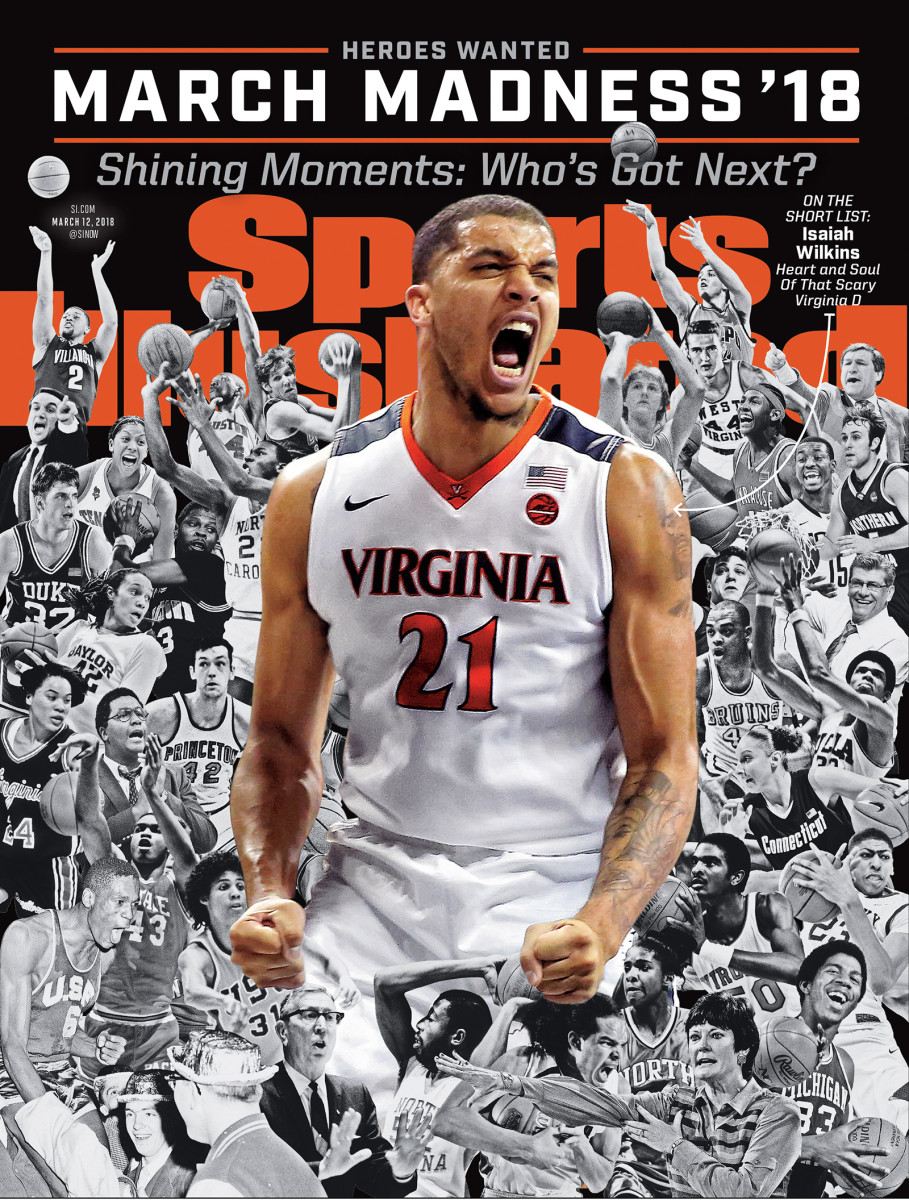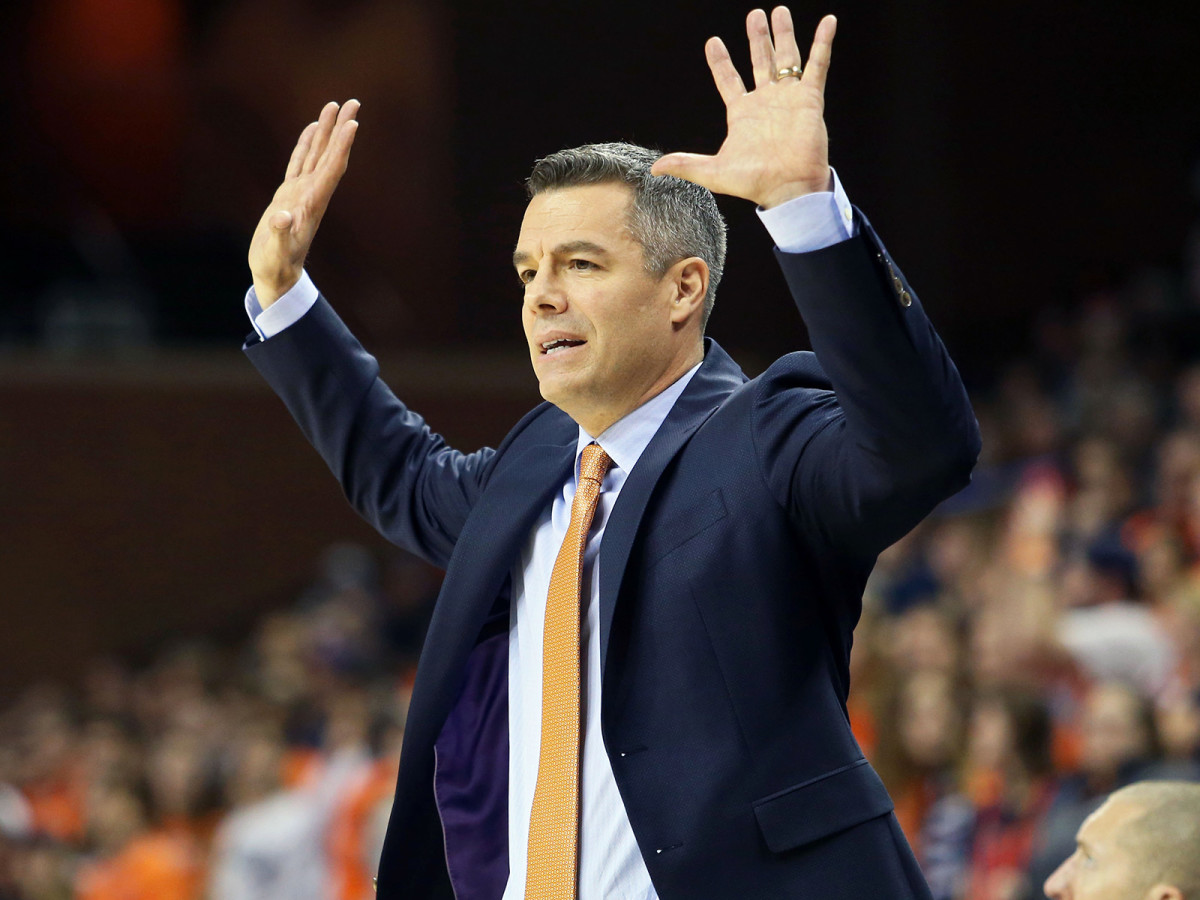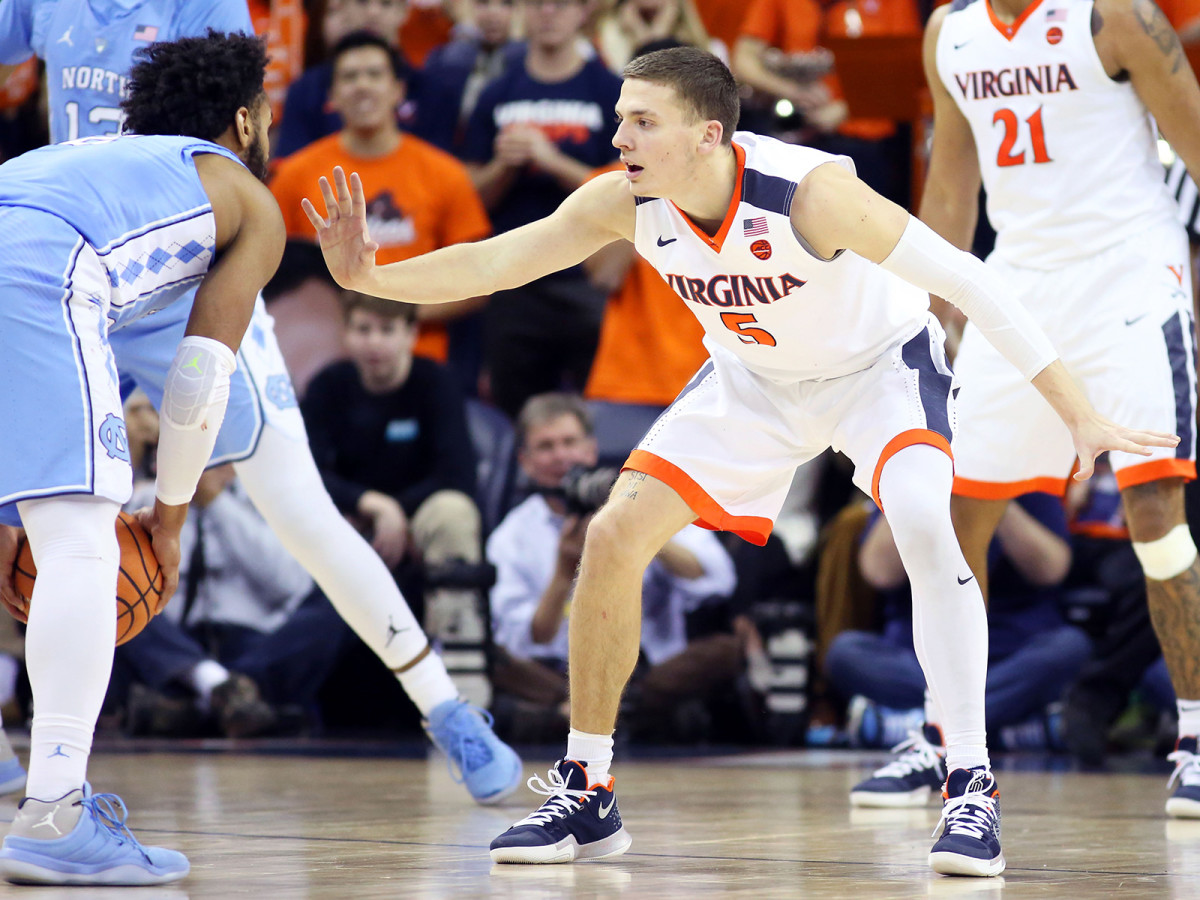Boring, Brilliant or Both? Virginia Vies to Weather the Madness With a Deadly Defense

This story appears in the March 12, 2018, issue of Sports Illustrated. Subscribe to the magazine here.
On Valentine’s Day, versions of the best-known love poem bounced around the Internet. The moderator of the Twitter feed that represents Reddit's college basketball subgroup published 11 different verses. This was the ninth:
Roses are red,
This joke has become lame,
Just like Virginia,
Who's ruining our game
The sentiment in that punch line is now as tightly attached to coach Tony Bennett’s team as Cavaliers forward Isaiah Wilkins is to opposing ballhandlers, especially as UVa (28–2 and the ACC regular-season champs) closes in on the top seed in the NCAA tournament. USA Today writer Nate Scott offered a more detailed take on the Bennett era in 2015, when the Cavs were on their way to a No. 2 seed: “UVa basketball is paint-drying, grass-growing, sixth-period-algebra boring.”
Coach turned ESPN analyst Fran Fraschilla prefers a different adjective. “I don’t subscribe to the theory that it’s boring basketball,” he says. “It’s winning basketball.” True, grinding defense, plodding pace and minimal scoring may not make for aesthetically pleasing hoops—in fact it may be the reason no other Final Four favorites mimic the Cavaliers. But UVa is playing its style better than ever this season, with the finest collection of athletes Bennett has coached. His Pack-Line D has evolved into a living organism that kills a team’s will to score. According to stats guru Ken Pomeroy, Virginia’s adjusted defensive efficiency as of March 3 was 83.9. That means with the data adjusted for the tempo played by the Cavaliers’ opponents, teams scored 83.9 points every 100 possessions. (A top 50 offense this season scores at least 113.8 points every 100 possessions.) If this holds through March, Virginia will have played the most dominant defense since Pomeroy began tracking these stats in 2002.
At times, the UVa defense is less a matter of strategy than a piece of performance art. On Feb. 24, the Cavs led Pitt at halftime 30–7—yes, 30–7—en route to a 66–37 blowout. That’s to be expected when a No. 1 squad, whose coach excels at inspiring consistent effort, faces one of the worst major conference teams in history. But wide-open, Big Dance–bound North Carolina didn't fare much better against the Pack-Line. In a visit to John Paul Jones Arena on Jan. 6, the Tar Heels shot 29.6% and fell 61–49. “It was a big ol’ butt kicking,” North Carolina coach Roy Williams said afterward. “Their defense was a million times stronger than our offense.”
Bennett comes by his approach honestly, having learned from the Pack-Line's originator. He played it for father, Dick, at Wisconsin–Green Bay and then coached under him at Wisconsin and Washington State before taking over the Cougars in 2006. (He came to Charlottesville three years later.) When Bennett yells to guard Kyle Guy to flash on a ballhandler at the top of the key, he's just echoing what his dad hollered at him.

Imagine drawing an arc on the court about 16 feet from the basket. (The three-point line is 20'9" out.) That is the Pack Line. When the ball is outside the line, the player guarding the ballhandler sprints to the perimeter, getting so close that he can guess what the guy ate for his pregame meal. The four other Cavaliers cluster inside the line, even if the players they are guarding are outside it. If, for example, the opposing point guard passes to a wing beyond the Pack Line, the defender on the point guard will drop within the line and the one guarding the wing will sprint out. If the ball is dumped inside, several Virginia players collapse on the recipient of the pass, often resulting in a turnover, a deflected pass or an ugly shot.
The Pack-Line is based on common sense, not reliant on tricks or secrets: Funnel the action toward your help and you'll probably force a contested shot. Even though it is nominally a man-to-man scheme, each player must guard the individual while still defending the whole. For the Cavs, a shot-clock violation is the sexiest possible defensive outcome because it accomplishes two of the Bennett’s major goals: allowing no points and reducing the number of possessions in the game.
It’s a physically and mentally grueling style to play, but it takes an even greater toll on opponents. Before Virginia beat Duke 65–63 on Jan. 27 at Cameron Indoor Stadium, Blue Devils guard Grayson Allen said that because the Cavs are so quick to recover, it often looks like all five players are guarding the ball.
Virginia coaches study stats both advanced and primitive, but when it comes to lockdown defense, they ultimately define it the way former Supreme Court Justice Potter Stewart defined obscenity: They know it when they see it. Did the ballhandler get harassed? Were the helpers in the correct positions? Did the opponent settle for the most difficult shot possible? This is why Bennett might praise the defense of a made shot or rip the defense of a missed one. The standard is the standard, and if the Cavaliers meet it, they'll probably win.
Playing alongside David Wingate with the Charlotte Hornets from 1992–93 through '94–95, Bennett, a 6-foot point guard, learned that a defender can do his job perfectly and still give up buckets. “I saw him play some of the best defense on Michael Jordan in a game,” Bennett says. “And Michael Jordan would just lean back a little more and ... bang! He made shots that could not have been defended any better.” The good news for the Cavs is that they’ll never have to face his Airness. Still, their opponents will come up with some difficult baskets. “We're not perfectionists, but with our defense, 70% of a team’s scoring is them hitting a tough shot,” Guy says. “We live with that.”
The Cavaliers practice the Pack-Line in its purest form in what they call the Closeout Drill. The defensive unit gets a breather if it can force the offense to miss a contested shot; allow a basket or an easy look, and the D stays on the floor. This forces Virginia’s players to maintain the principles of the Pack-Line even when they are exhausted. In past seasons Bennett used the drill in preseason practice and when the team had longer breaks between games. This year, he’s used it in almost every practice.
That’s one reason no one panicked in the locker room when the Cavaliers went into halftime down 32–22 to Florida State in Tallahassee on Feb. 7. The Seminoles had buried a few long three-pointers and made some acrobatic layups. “Degree of difficulty: 9.9,” play-by-play announcer Bob Rathbun said as Florida State guard Terance Mann connected on a leaner in the lane in the first half. Rathbun may as well have channeled the inner monologues of the Cavaliers. “If they hit them, you just tip your hat,” sophomore guard Ty Jerome says. “Over time, teams that are going to have to take a tough shot with a hand in their face every possession, it’s going to wear on them.” Sure enough, it wore on the Seminoles, who missed 15 of 22 field goal attempts in the second half and didn’t make a single field goal over the final 9:01. Virginia surged to a 59–55 win.
Afterward Bennett referred to a sign assistant Brad Soderberg keeps in his office. “It's a Mike Tyson quote, actually,” Bennett said. The quote? “Everyone’s got a plan until they get punched in the mouth.” Bennett's team had taken a left hook and remained faithful to the plan.

Why is Virginia’s defense even more smothering this year than in years past? The personnel. At 6'7" and 227 pounds, Wilkins is big enough to excel inside the Pack Line and quick enough to disrupt outside it. The senior led the Cavaliers in rebounds, blocks and steals last season, and he leads them in rebounds (6.4) and blocks (1.5) this season. The pacesetter in steals is the 6'5" Jerome, one of a quartet of four-star recruits (also including McDonald’s All-American Guy, 6'7" wing De’Andre Hunter and 7'1" post Jay Huff) who signed in 2016. The length of Jerome, Hunter and 6'5" guard Devon Hall makes the Pack Line feel as if it stretches to the three-point arc.
Thanks to the development of Guy and Jerome, the offense is also more dynamic. The Virginia-is-boring crowd claims that the Cavs want to drain the shot clock every possession. That isn’t true. Bennett has no hard-and-fast rules about offensive pacing. “Defense you can rule with an iron fist,” Bennett says. “Offensively, that’s more guys using their creativity and their feel.”
Guy, Jerome or Hall will happily pull the trigger on an open three with 20 seconds remaining on the shot clock, and Bennett won't complain. “I don’t think they control the tempo,” UNC’s Williams said after the aforementioned butt kicking. “I think they just pass the ball until they get exactly the shot they want.” This also can hurt the Cavaliers. When they struggle to score, it’s harder for them to catch up. That’s how they wound up losing 65–39 to Florida in the second round of last year’s NCAA tournament. But this isn’t exactly a flaw in the system; almost every team that shoots poorly loses.
Virginia has played the slowest tempo in Division I each of the past two seasons. This year, their adjusted tempo is 59.0 possessions per 40 minutes. (In contrast, the major conference team with the fastest tempo—Oklahoma—ranks third nationally with 75.9.) This is part of the plan, and it’s also a major reason the Cavaliers get called dull. But consider this from Bennett’s perspective: He came to Charlottesville knowing he’d have to compete with Duke, North Carolina and the rest of the always-competitive ACC. Virginia doesn’t typically sign McDonald’s All-Americans. So Bennett had a choice: Recruit like the big boys (not likely) or play a style that suits the kind of players he can sign. Bennett chose the latter. Four ACC regular-season titles later, the fact that the Cavs keep improving has attracted even better athletes.

If their favorite teams miss the NCAA tournament this year, members of these groups should adopt Virginia:
• SEC football fans: Remember how much you loved the defense on display in that 9–6 LSU overtime win at Alabama in 2011? That's the football version of every Virginia basketball game. (And don’t rule out the possibility of the Cavaliers allowing single digits in a half during the tournament.)
• Soccer fans: UVa’s defense suffocates opponents so thoroughly that possessions that do result in points tend to be quite breathtaking, just like the infrequent goals in the beautiful game.
• Analytics freaks: Dick Bennett may not have worried about adjusted tempo when he designed the Pack-Line, but his system embraces everything the advanced analytics movement cherishes. It forces low-percentage shots on D while seeking high-percentage shots on offense, and if everyone plays to the mean, Virginia wins.
• Gamblers: The Cavaliers have hit the Under in 20 of 30 games this season. Vegas still hasn't grasped the dominance of the Pack-Line.
After seeing their system succeed, the Cavs have become inured to the backlash. Call it boring, call it brilliant—they don’t care. “We wear teams down,” Guy says. “When you see that defense for 40 minutes, eventually we’re going to get our way.”
